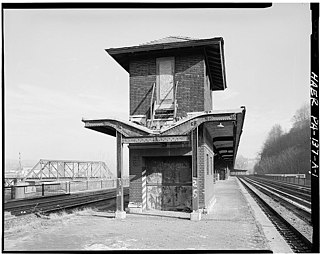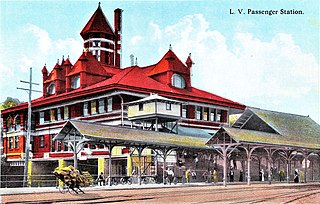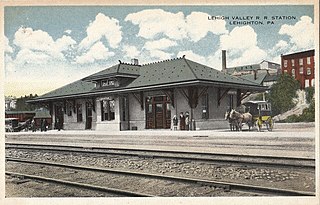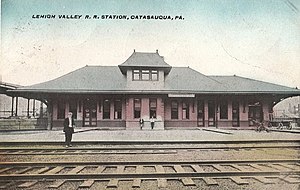
Sayre is a borough in Bradford County, Pennsylvania, United States. It is part of Northeastern Pennsylvania. It is the principal city in the Sayre, PA Micropolitan Statistical Area. It lies 18 miles (29 km) southeast of Elmira, New York, and 30 miles (48 km) southwest of Binghamton. It is currently the largest city in Bradford County. In the past, various iron products were made there. In 1900, 5,243 people lived there; in 1910, 6,426 people lived there, and in 1940, 7,569 persons made their homes in Sayre. The population was 5,403 at the 2020 census.
The Lehigh Valley Railroad was a railroad in the Northeastern United States built predominantly to haul anthracite coal from the Coal Region in Northeastern Pennsylvania to major consumer markets in Philadelphia, New York City, and elsewhere.

The Lehigh Crane Iron Company, later renamed Crane Iron Company, was a major ironmaking firm in the Lehigh Valley from its founding in 1839 until its sale in 1899. It was based in Catasauqua, Pennsylvania, and was founded by Josiah White and Erskine Hazard, who financed its development through their Lehigh Coal & Navigation Company, which promoted the then-novel technique of smelting iron ore with anthracite coal. This was an important cost and energy savings technique, credited with eliminating the need for either expensive charcoal or coke producing processes and transport costs that proved central to the acceleration of the American Industrial Revolution.
The Catasauqua and Fogelsville Railroad was built in the 1850s to transport iron ore from local mines in Lehigh and later Berks County to furnaces along the Lehigh River in eastern Pennsylvania. Originally owned by two iron companies, the railroad later became part of the Reading Company, and parts of it remain in operation today.

The Ironton Railroad was a shortline railroad in Lehigh County, Pennsylvania. Originally built in 1861 to haul iron ore and limestone to blast furnaces along the Lehigh River, traffic later shifted to carrying Portland cement when local iron mining declined in the early 20th century. Much of the railroad had already been abandoned when it became part of Conrail in 1976, and the last of its trackage was removed in 1984.

The Lehigh Line is a railroad line in Central New Jersey, Northeastern Pennsylvania, and the Lehigh Valley region of eastern Pennsylvania. It is owned and operated by the Norfolk Southern Railway. The line runs west from the vicinity of the Port of New York and New Jersey in Manville, New Jersey via Conrail's Lehigh Line to the southern end of Wyoming Valley's Coal Region in Lehigh Township, Pennsylvania.

Bethlehem Union Station is a former train station located in the South Side neighborhood of Bethlehem, Pennsylvania. It was built in 1924 by the Lehigh Valley Railroad and the Reading Company, replacing an earlier station built in 1867. Passenger service to Philadelphia on the SEPTA Regional Rail Bethlehem Line lasted until 1981. The station was renovated in 2002 and used for medical clinics beginning in 2003. It is owned by St. Luke's Hospital.

Easton is a defunct train station in Easton, Pennsylvania. It was originally built by the Lehigh Valley Railroad. As of 2017, the structure still exists and was blighted for at least 20 years, since its closing in the 1970s. The city of Easton obtained permission from Norfolk Southern Railway to clean up the property. The location only recently became a focal point for the city with the opening of Interstate 78 in the 1990s.

Allentown was a train station in Allentown, Pennsylvania. It was opened by the Lehigh Valley Railroad in 1890 and closed in 1961. The building was demolished in 1972. The station was located one block west of the Central Railroad of New Jersey's Allentown station.

Bethlehem is a disused train station in Bethlehem, Pennsylvania. It was constructed by the Central Railroad of New Jersey (CNJ) in 1873. Passenger service to the station ended in 1967. A restaurant opened within the station in 1976, and the building has continued to serve that role through several changes in ownership.

The Lehigh Valley Terminal was a railroad station in downtown Buffalo, New York. The Lehigh Valley Railroad opened it in 1916, replacing an older station one block east at Scott and Washington streets. Lehigh Valley trains served at the station included the Black Diamond,Maple Leaf, and Star. The station handled the Lehigh Valley's passenger traffic in Buffalo until 1955, when it was demolished to make room for the Niagara Thruway (Interstate 190). The Lehigh Valley moved its operations to a smaller station outside the downtown area at Dingens and South Ogden Streets, which served until the end of all Lehigh Valley passenger service in 1961. The terminal also hosted the Erie Railroad's passenger trains from 1935 until 1951, when that railroad ceased serving Buffalo.
Batavia station was a Lehigh Valley Railroad station in Batavia, New York, located on the Lehigh Valley main line.

Rochester Junction station was a Lehigh Valley Railroad station in Mendon, New York. The station was at the junction of the Lehigh Valley's main line and its Rochester Branch, which provided access to Rochester, 13.2 miles (21.2 km) to the north.
Slatington station was a Lehigh Valley Railroad station in Slatington, Pennsylvania, located on the Lehigh Valley main line. The station also served the Lehigh and New England Railroad; the Reading Company at one time had an adjacent station. The Central Railroad of New Jersey had an unconnected station across the Lehigh River in Walnutport, Pennsylvania.

Laurys station, also known as Laury's station, was a Lehigh Valley Railroad station in Laurys Station, Pennsylvania. Both the station and locality drew their name from David Laury, a local notable who established a hotel on the site in 1832 and later served as postmaster.

Lehighton station was a Lehigh Valley Railroad station that was located in Lehighton, Pennsylvania, USA. It was part of the Lehigh Valley main line, and was also the eastern terminus for Hazleton Branch passenger trains, although the branch diverged at Penn Haven Junction, north of Jim Thorpe.

The Jim Thorpe station, also known as the Mauch Chunk station or East Mauch Chunk station, was a Lehigh Valley Railroad station that was located in Jim Thorpe, Pennsylvania.

Flemington Junction station is a defunct Lehigh Valley Railroad station in Flemington Junction, New Jersey. It was located at the junction of the Lehigh Valley's Flemington Branch and Main Line, although the name predated the opening of the branch by eight years.
The Southern Central Railroad is a defunct railroad which operated in the state of New York in the nineteenth century. The company's line ran from Fair Haven, New York, on the south shore of Lake Ontario, to Athens, Pennsylvania, in the Southern Tier and just over the border into Pennsylvania. The company was incorporated in 1865 and became part of the Lehigh Valley Railroad system in 1895. Most of its line was abandoned by the Lehigh Valley Railroad between 1937–1979; the portion between Harford Mills, New York, and Owego, New York, is owned by the Tioga County Industrial Development Agency and operated by the Owego and Harford Railway.
The Catasauqua Branch was a short railway line in Lehigh and Northampton Counties in the state of Pennsylvania. It was part of the Lehigh and New England Railroad and ran from a point south of Bath to Catasauqua, where it interchanged with the Central Railroad of New Jersey and Lehigh Valley Railroad. The line opened in 1914 and was partially abandoned in 1961 on the Lehigh and New England Railroad's bankruptcy and closure. Conrail abandoned the remainder in the 1990s.














